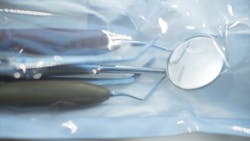A helping hand: Some tips on hand scaling
We are all experiencing the vast changes that COVID-19 has brought to our profession: new protocols, increased personal protective equipment (PPE), additional engineering controls, and the like. We are learning with time and experience as we navigate this new landscape that the added protection and precautions can come with some challenges, frustration, and discomfort.
One of the areas that has been impacted is instrumentation. Individual state regulations, specific rules established by your employer, and the potential lack of PPE and engineering controls currently available have some of us limited in the use of power scalers. This is forcing a temporary need for some to fully rely on manual instrumentation versus a blended approach.
I have taught first-year clinical instrumentation for many years. What I’ve experienced in my own life as a practicing clinician, as well as observing as a hygiene consultant, is that a lot of those basics we learn in school (that often sound like a lot of rules!) don’t always transition with hygienists when they begin to practice outside of the school setting. We are in a constraint-driven profession (time, resources, patient difficulty level, etc.). In those first few years out of school, we have so much we are still learning and trying to integrate as we juggle a full schedule, and sometimes with less than optimum equipment. Sure, we can get the job done, but is there a better way to get the most out of each stroke we take with an instrument?
The following are some reminders and tips to help you get the most out of hand instrumentation and to protect your hand health.
Pick your partner
Have you ever worked on something around your house, and all you had was a flat-head screwdriver to use on a Phillips screw, yet you were able to make it work? Instrument selection can be like that. With time and experience, you can adapt pretty much any instrument enough to make it work, but in the end, was it the best choice? Was it the most effective, time efficient, comfortable for the patient, comfortable for you (taking into consideration good ergonomics)?
Hygiene instruments can be much the same way. Having a combination of different types of instruments for different scenarios will allow you more efficient removal. Consider the different types of patients you have.
- When working with periodontally involved patients, do you have longer shank instruments (After Fives) with smaller working ends (Minis) to allow you better access to pocketing? Do you have files for furcation areas?
- For patients with heavier or more tenacious calculus, do you have rigid shanked instruments that have less flex against a deposit and can more readily remove it, lessening the burden on your hand?
- Are you using a combination of area-specific curettes, or are you relying solely on universal type instruments? If you are more of a universal user, are you able to adapt it well in all areas to best engage the cutting edge for efficient removal? Are you able to do this keeping good hand ergonomic principles in mind? Do you have a combination of sickles and curettes to allow the best access to different areas while minimizing trauma to the surrounding tissues?
I once thought that picking up different instruments designed for different tasks would be more time consuming. I learned with experience that the opposite is true. A systematic approach (using an instrument where it is appropriate throughout the patient’s mouth until you are ready to move on to the next instrument) is faster and more efficient than trying to adapt a poorly fitting alternative. I think of it this way: You can walk a mile in a pair of dress shoes, but you’d likely get there faster and more comfortably in sneakers!
Getting a grasp
A solid grasp is the foundation of proper hand instrumentation. Each finger has a specific job, and correct finger placement in your grasp allows for precise control of the working end. It also increases the power of your hand and reduces the risk of repetitive stress and strain that can lead to long-term injuries.
A quick review of finger placement:
- The thumb and index finger rest lightly opposite each other on the handle, with a space between them. The space allows you to easily roll the instrument without splitting your fingers and compromising control.
- The side of the pad of your middle finger (alongside the nail) rests against the functional shank, and the other side of the pad of your finger rests against (or can overlap) your ring finger.
- The ring finger should be stable, straight, and firmly planted as your fulcrum. This finger steadies your hand for increased control and minimizes slipping.
- The pinky stays neutral and close to the ring finger.
- Fingers should stay together like a hand in a mitten, and the grasp should be light.
The single greatest cause of hand injuries in dental hygienists is excessive pinch force between the thumb and index finger.1 Even as a person who taught for so many years, I still tended to have a “death grip” when I was working. Over time, the constant force of my thumb against the handle resulted in long-term injury.
The following are strategies to prevent excessive pinch force:
- Use the least amount of pressure to do the job and relax fingers between strokes.
- Alternate working on difficult areas with less difficult areas to give your hand a rest between.
- When you need more power, increasing the pressure on your fulcrum will allow you to increase force without needing as firm of a pinch force.
- Keep your instruments sharp and sharpened correctly to preserve the original design. Otherwise, it takes a lot more pressure and an increased number of strokes for removal. Dull, improperly maintained instruments and those that need to be replaced also force your wrist out of a neutral position, increasing the likelihood of musculoskeletal disorders.
- The best instruments for your hand are those with handles that are round (versus octagonal), thick (at least 10 mm in diameter), and lightweight (less than 15 grams). Additionally, prominent knurls (or texturing) of the handle results in increased friction and less of a need to pinch so tightly.
- Properly adapt the instrument and the cutting edge to increase effectiveness. Doing this results in being able to successfully remove deposits with fewer strokes and less pinch force or pressure. This leads me to the next point…
Adapt to your surroundings and be on the cutting edge
In order to get the most from each stroke, it is important that the instrument is properly engaged with the tooth to decrease the force and number of strokes necessary to get the result you want.
Proper adaptation of a removal instrument is having only the leading third of the working edge applied to the tooth (that is the tip third or toe third of your instrument). Applying the full working end will result in patient discomfort and potential trauma (as the tip or toe lifts up from the tooth toward the gingiva). Further, directing your pressure to the leading third allows increased effectiveness of the instrument with less pressure.
Checking to be sure your cutting edge is properly “locked” into the tooth will also allow for more effective strokes with less pressure. With a Gracey curette (which is designed so the cutting edge is sloped to facilitate proper angulation), keeping the terminal shank parallel to the tooth surface ensures that you have the correct tooth to blade angulation. With instruments that do not have a sloped working end (like a sickle or universal curette, for example), position the instrument so that you have a 60-70 degree angle between the instrument face and the tooth.
One of the ways I’ve practiced this with students is to apply nail polish or acrylic paint to a typodont. You can immediately see the difference in effectiveness with correct adaptation and angulation. Even if students were slightly off on one or the other, they noticed it took a lot more work to remove the coloring applied.
Rock on
Consider the small muscles in your fingers, and now compare that to the muscles of your forearm. Finger flexing (using the finger muscles to power your instrument) will fatigue those muscles quickly. Using the power of the muscles of your wrist and forearm as a unit (by rocking on your fulcrum) results in more powerful strokes with much less fatigue. The motion looks similar to the way your hand would look if you were turning a doorknob. It is also important to watch your patient/operator positioning to keep your arms and wrists as neutral as possible. Not only will this help to protect your body, but it makes obtaining the proper angulation for scaling much easier!
These are just a few ideas that may help you make some adjustments to your hand scaling technique. The ideal choices are those that promote effective, efficient removal, and create the least amount of stress and strain on the hand. The end goal is to get the most from each stroke, provide the best care for your patients, and to protect the health of your hands and wrists.
Reference
- Sanders MA, Turcotte CM. Ergonomic strategies for dental professionals. Work. 1997;8(1):55-72.
Julie Whiteley, BS, RDH, is certified in human resources. She holds degrees in business administration and dental hygiene and has worked extensively in both fields. She is on the faculty of Massachusetts College of Pharmacy and Health Sciences University in Boston. Julie bridges her knowledge and experience from business, clinical hygiene, and teaching to deliver information and programs that enhance dental practices. Contact her at [email protected].
About the Author

Julie Whiteley, BS, RDH
Julie Whiteley, BS, RDH, is certified in human resources. She holds degrees in business administration and dental hygiene and has worked extensively in both fields. She is on the faculty of Massachusetts College of Pharmacy and Health Sciences University in Boston. Julie bridges her knowledge and experience from business, clinical hygiene, and teaching to deliver information and programs that enhance dental practices. Contact her at [email protected].
